Final report for GNE20-244
Project Information
White-tailed deer (Odocoileus virginianus; WTD) pose a risk to livestock health due to the fact that they may shed a parasite, meningeal worm (Parelaphostrongylus tenuis; P. tenuis) also called brainworm. Farms where livestock grazing systems overlap with WTD habitat (P. tenuis definitive host) and that harbor high numbers of terrestrial gastropods (P. tenuis intermediate hosts) face elevated risk of brainworm infection of livestock. Brainworm often causes severe neurologic disease or death in livestock, primarily small ruminants (sheep, goats, llamas and alpacas). Small-scale farmers face risks of production loss due to meningeal worm; even small increases in mortality can have large financial impacts on small farms. The objectives of this project include 1) establishing baseline abundance for brainworm on Maine farms, 2) estimating risk of P. tenuis infection to small ruminants in overlapping grazing systems with WTD and 3) proposing risk management and preventive measures to producers.
In our first year, 2020, we were restricted by Covid-19 protocols, limiting our field and laboratory activities. However, we were able to collect preliminary data and test and refine methods. In 2021, less restrictive Covid-19 conditions allowed us to collect gastropods and WTD fecal samples from six farms in Maine to determine meningeal worm prevalence in pasture systems. Prevention methods such as pastured poultry and mowing treatments were investigated via field research. Producer education was developed to minimize risk, to aid early detection of elevated P. tenuis risk, and to direct producers to seek appropriate veterinary treatment. Several abstracts and presentations to national and regional audiences have been produced. Additional educational materials were disseminated via Extension publications, a recorded presentation, and a peer-reviewed publication during 2022. In 2022, we replicated methods on the six farms, plus a second year of mow treatment. Farmers from the project gave “exit interviews” for us to assess knowledge, attitudes, and practices before and after our research on their farm. Results from the past two years of data collection for each farm were shared with each farmer, and summarized risks along with estimates of risk classification, and recommendations to prevent or control meningeal worm infection in their small ruminants were shared with all farmers.
On the six small ruminant farms sampled in this study, gastropod and larval populations varied widely. Out of 5,400 digested gastropod samples analyzed in two years, 2.5% were found to harbor meningeal worm, though individual farms varied with up to 10% infected. Over all farms, the average percentage of gastropods carrying larvae, in general, was 4.5%. Genetic identification had varied success. Of the 193 samples submitted for genetic analysis, 98 (51%) samples were identified, of which 81 (83%) samples identified at P.tenuis. Gastropod temporal population trends varied from farm to farm. However, all farms experienced a population reduction in June, likely due to widespread temporary drought conditions, snail life cycle, or a combination of both. The effect of climatic conditions, such as soil moisture, air temperature, humidity, vegetation type and height, and shade content also are correlated with gastropod presence. All farms experienced WTD presence in or around livestock grazing areas.
Experimental treatment methods aimed at mitigating risk of P.tenuis exposure to small ruminants included pastured poultry and mowing. In 2021, a group of approximately 200 laying hens, deployed in a rotational strategy on pasture proved to significantly reduce gastropod populations. Additionally, intensive mowing to keep vegetation short (<6”) was an effective method at reducing snail populations. A combination of these prevention methods in areas of high WTD use and gastropod abundance may reduce risk of P.tenuis in small ruminants.
Our 2020 national survey suggests that most small-ruminant farmers know about meningeal worm risk on farms (95%) and a large proportion have had suspected cases (41%). 98% of surveyed farmers said their farm was near white-tailed deer habitat, and 88% said that deer were observed near their livestock grazing system.
The exploration of transmission factors of P. tenuis and other gastropod-born helminths between wild cervids and small ruminants can inform methods to decrease risk. In grazing areas with observed WTD use and high gastropod abundance, risk of P. tenuis transmission to small ruminants increases. Specific microclimatic conditions may increase or decrease gastropod populations, such as broad-leafed plants with deep roots (i.e., burdock & dandelion) provide ample living conditions for snails to sustain even during drought periods. By understanding risk factors associated with gastropod- borne helminth transmission, farmers can make management decisions to minimize the threat of disease to their livestock. In addition, prevention methods that reduce snail and slug populations can decrease risk. In systems where farmers have suspected meningeal worm cases, pastured poultry before small ruminant grazing and/ or intensive mowing in areas of abundant gastropod populations can significantly reduce gastropod populations, thus reducing the chances of P.tenuis uptake. These approaches provide farmers with a solution to controlling P.tenuis transmission to livestock. Emotional and financial effects from the morbidity or mortality caused by this worm may be lessened due to these methods.
To date, there is no diagnostic for P.tenuis in small ruminants, however, promising developments in this area using blood serum have proved effective in detecting P.tenuis presence in moose. Because the symptoms of the worm’s presence within livestock can be mistaken for many other diseases, such as rabies, listeriosis, polioencephalomalacia (PEM), and bacterial/ viral meningitis, farmers must take caution when assessing animals, as some of these can transmit to humans. It is vital for farmers to establish a relationship with a veterinarian for the care of sick animals and for guidance in treating suspected meningeal worm cases. Prevention methods recommended in this study have associated financial costs such as feeding chickens or fuel for mowing machines. Additionally, these approaches require time for moving temporary fences or to mow. Pastured poultry promotes healthy soils and is a common practice in sustainable or regenerative farming systems. Conversely, frequent mowing may reduce soil moisture and quality. Nonetheless, repetitive mowing in areas of gastropod abundance can lower populations by reducing suitable habitat. Further studies to identify which poultry species are more effective at gastropod reduction may be warranted.
Conflicts between farming and nature have been recorded for centuries and are well known. Sustainable farming provides solutions for farmers to work with the environment (soil, water, and even wildlife) in a holistic way. Integrative pest management (IPM) using biological controls for unwanted pests is a common practice in sustainable agriculture. The implications of reducing gastropod populations are not well known. These molluscs are important nutrient cyclers and decomposers. Further studies to determine the long-term effect of gastropod reduction on pasture systems may determine if their presence is more vital than their absence.
An extension of this study, formed by two undergraduate students, found presence of microplastics within gastropods, and livestock and deer feces. This finding raises concerns for the health of these animals and the environment. Our survey indicated that farmers are concerned about microplastic effects for themselves, their animals, and the environment. More studies on the effect of plastics in livestock and soils, as well as behavior of farmers/ use of plastics, could enact change in farmer use of plastic on farms and even policy for plastic uses.
1) Assess the prevalence of P. tenuis on Maine’s agricultural landscape
Results from our nation-wide survey will give general insight to the perceived incidence of P.tenuis on farms. Examining fecal samples and gastropods in the lab will indicate the prevalence of brainworm on Maine farms. Necropsy, followed by histology, of animals showing neurologic symptoms before death will be performed as appropriate using the UMaine Veterinary Diagnostic Laboratory resources
2) Establish the risk factors associated with brainworm to determine likelihood of infection to livestock.
Farmers across the north east utilize various grazing strategies which often overlap with WTD habitat. This, in combination with high gastropod numbers,creates risk of livestock brainworm infection on a farm. Weather trends, grass height, wetness, topography, and woody debris may change gastropod behavior or abundance. These factors, once quantified, can be entered into a statistical model to determine the likelihood of infection to animals exposed to different grazing systems, climatic events, and preventive treatments. These factors will be explored across several farms in Maine where pastures support deer and small ruminant livestock, such as sheep and goats. This study will be the first evaluation of P.tenuis on Maine livestock farms.
3) Create management strategies for farmers.
After analyzing the risk factors associated with increased prevalence of brainworm, preventive measures to combat the parasite will be suggested in project publications. In a closely related project, integrated pest management using poultry (ducks, other species) is being explored by an undergraduate member of the Lichtenwalner lab. This additional project has been funded via 2 internal grants and the IACUC approval is in place.
The purpose of this project was to evaluate risk of brainworm to domestic livestock, and to evaluate risk management techniques. Brainworm infection of small ruminants often causes death, resulting in emotional and financial difficulties for small farmers. Diagnostic serologic tests are not optimized for use in livestock, and diagnostic fecal examinations don’t work for livestock, as the worm cannot reproduce in any species other than the white-tailed deer (Odocoileus virginianus; WTD). Additionally, preventive practices for agriculture have not been well documented. The results of this project can inform future outreach efforts to producers about risk assessment, preventive steps, and recognition/treatment for this deadly infection in livestock.
Problem 1: Diagnosis.
Currently, diagnosis of P. tenuis in livestock is neither easy nor cost-efficient but is important due to zoonotic and very serious “look-alike” diseases, like rabies, eastern equine encephalitis (EEE), listeriosis, polioencephalomalacia (PEM), scrapie, and bacterial meningitis. While infection can be confirmed by histology of the spinal cord and brain post-necropsy, this is time-consuming and expensive. Recently, a serologic test has been developed for brainworm detection in moose, but is not validated for small ruminants. As well, response to larvicidal treatment may assist with diagnosis, but may enhance anthelmintic resistance on small ruminant farms, a serious problem for farmers.
Problem 2: Risk Evaluation and Risk Management.
In natural grazing systems, P. tenuis risk to livestock is not well documented. Farmers in the North East who graze their animals in WTD habitat would be expected to face an increased risk of brainworm exposure, as approximately 84% of WTD are infected with brainworm. Environmental conditions and frequent mild winters/early springs increase deer survival, resulting in escalated production of larvae. Additionally, gastropod abundance might be expected to increase under these conditions. Height of vegetation, wet fields, and woody debris may also increase gastropod presence.
This project quantified the variables associated with risk of infection within different livestock grazing strategies in high deer population areas by visiting several farms across Maine. Observations included measuring and identifying vegetation in grazing plots, documenting climate and weather trends, assessing deer abundance and movement with the use of game cameras, identifying infected gastropod species, and counting infected gastropods within the study sites.
Problem 3: Producer Knowledge.
By deploying a nationwide survey, we gained insight about producer knowledge of the disease and quantified the perceived infections across the United States. Questions also focused on grazing systems and WTD habitat overlap with livestock.
Cooperators
- (Educator)
Research
Establish the risk factors associated with brainworm to determine likelihood of infection to livestock.
To establish the risk factors associated with brainworm, visits to working farms were necessary. Sampling was held over ten weeks between May- September for two seasons.
- Study locations: From voluntary recruitment, six farms in Maine were selected at random based on project criteria: forty or more small ruminants (goats, sheep, alpacas, and/or llamas), an abundant and active deer population, and observation of gastropods. Farms were mapped to document areas of wetness, forest, field, rockiness, and man-made influence (driveways, barns, etc.).
- Sample sites: Two grazing fields per farm were chosen randomly. Sampling sites within the field were stratified random samples to include inside, outside, and on the fence line of pastures. PVC grids measuring 45cm x 90cm and a search time of ten minutes were used for collections.
- Vegetation within the field, on the field’s fence line or boundary line, to 10m out of the grazing area, were documented. The grazing system which sample sites are located were also recorded (rotational, permanent pasture, dry lot, etc.). Within the grazing system, vegetation density, height, and species were recorded.
- When visiting sample sites, climatic data such as ambient air temperature, precipitation, wind direction, and humidity were recorded.
- Game cameras were deployed on habitat buffers (field edges) to record deer movement and visitation to the field. Deer abundance is related to increased brainworm within gastropods, since deer feces carry the infective larval form that must gestate within the gastropod intermediate host.
Document prevalence of brainworm on Maine farms.
To establish the baseline of prevalence of brainworm, we experimented on gastropods and on deer fecal samples from the farms, mentioned above, in the laboratory. A survey, made by an undergraduate in our project group, that encompasses risk perception questions was sent to producers across the country.
- A survey was sent nationwide to assess producer knowledge and risk perception of brainworm. Questions also focus on grazing systems and WTD habitat overlap with livestock.
- Collection of deer fecals: fecal samples from deer were collected in or near the livestock pasture.
- Examination of fecal pellets for P. tenuis: deer feces from sample fields were placed in a Baermann apparatus to extract stage 1 larvae.
- Collection of terrestrial snails and slugs: gastropods were collected by stratified random sampling near the fence line, interior pasture, and outside the pasture (mentioned above).
- Examination of gastropods for P.tenuis: Gastropods were placed in an artificial digest to entice the third-stage larvae out of the host tissue. These were quantified and genetically tested.
- Necropsy was performed at the UMaine Veterinary Diagnostic Laboratory on any small ruminants from these farms that had neurologic symptoms leading to death.
Surveying for gastropods on a Maine farm.
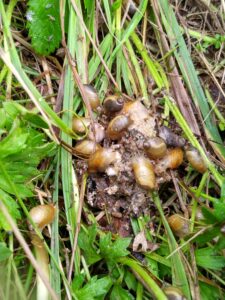
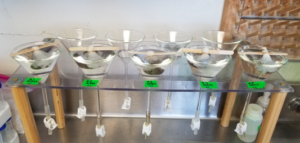
Create management strategies for farmers.
Pastured poultry and mowing were the primary treatment we examined as control against terrestrial gastropods. Creating management strategies for our participating farmers can be informed by snail and slug population numbers, brainworm larva "dose" within gastropods or numbers of gastropods infected, gastropod habitat preference, and climatic variables.
- Pastured poultry effectiveness: Large-scale organic poultry growth operations often place poultry on their fields to manage for insect pests, rejuvenate the soils, and substitute feed. We examined the before-and-after poultry foraging effectiveness on reducing gastropod numbers. Three 10m lines were surveyed for ten minutes each before and after poultry exposure to pasture.
- Mowing effectiveness: Shortening vegetation has been shown to reduce invertebrate populations. Population densities of gastropods were measured to determine the effectiveness of mowing on gastropod control with a random complete block design.
- Duck effectiveness in a lab setting: Members of our group for an undergraduate capstone project (not part of this proposal) tested the effectiveness of ducks as “snail grazers.” Ducks were experimentally infected with snails with dosed P. tenuis to test if the ducks readily ingest gastropods, if they become infected, if their enteric tract kills the infective larvae, and if they expel viable P. tenuis larvae in their feces.
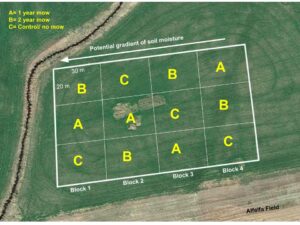
Gastropod and Larval Collection Results:
In 2021 and 2022, the graduate student researcher and undergraduate research assistant visited six different farms an average of 1.5 times per month from mid-May until early September. Farm locations in Maine were coastal, mid-coast, central, and western/ mountains. The majority of farmers rotated herds on pasture throughout the summer. During farm visits by the student team, gastropods were gathered in the mornings (average collection duration 3 hours). At each collection, biotic and abiotic factors were recorded such as soil moisture, air temperature, air humidity, dew point, weather, vegetation type and height, duff depth, and shade cover. Animal presence and duration of grazing on pasture exposure was also recorded. Additionally, any instance of sheep on the farm with neurological symptoms, and any treatment were recorded. Monthly deer and sheep fecal collections from the pasture areas were evaluated using a Baermann apparatus for live larvae. Game cameras were deployed to observe deer presence on livestock grazing areas.
In total, we collected 5,534 gastropods which consisted of 96% snails (n=5337) and 4% slugs (n=197). The vast majority of gastropods were amber snails (family Succineidae). Because smaller gastropods were pooled together in test tubes, a total of 5391 samples were digested and inspected for larvae. Of these, 281 were positive for larvae. Viable larvae (not broken or degraded) were extracted or imaged. Based on morphological measurements of larvae, 42% were identified as P.tenuis. Gastropods were 2.5% positive for meningeal worm and 4.5% positive for all larvae in general. Genetic analysis of 90 viable samples collected from snails confirmed 81 individuals to be meningeal worm (83%), 4 individuals to be Muellerius capillaris (lungworm; 4%), and 13 to be environmental or wildlife nematodes (13%). Of the six farms, larval content rates varied from 0%- 10% depending on year. Below are the findings for each farm:
- Farm A mid-coast: This farm was classified as high risk, due to the number of infected gastropods, high parasite loads within gastropods, and symptomatic sheep cases. The Katahdin flock of 50-110 sheep were rotated intensively as groups of 20-50 starting mid- May. This farm had the highest abundance of gastropods (n=3808) and larvae (n=176) with a larval infection rate of 3%. Gastropod populations dropped slightly in June of each year, but rebounded in July and again in August. Larval content was also the highest during these months. Deer were seen via game camera jumping over fences to graze on pasture before and after sheep rotations in both research pastures. Deer fecal pellets were difficult to find due to vegetation height and thickness. The deer pellets we found had dorsal spined larvae which were collected and frozen. Five lambs from Farm A had clinical symptoms of P.tenuis (three around September, 2021; one in January, 2022; one in April 2022). The farmer reported that the first ewe lamb was “down with a stiff neck and back” and “catatonic state.” It was treated with thiamine and a 5 day regimen of cydectin, valbazen, and dexamethasone. The second and third lambs showed signs of ataxia and weakness in the hindquarters; these lambs were also treated with the same 5 day regimen. Three lambs recovered, although they continue to have mild ataxia. Two lambs were euthanized and one was available for necropsy. Gross necropsy revealed no indication of trauma, but found large sublumbar abscesses and many thrombi. Results were inconclusive, but thought to be related to meningeal worm.
- The rotational grazing strategy on this farm may be a factor in abundant gastropod populations. Notably, the farmer actively strives for high soil moisture to promote healthy pasture vegetation. Rotation of sheep occurs when grasses are folded over, not by the height of the vegetation (i.e., the “ankle high” rule). In the fields closest to the barn, sheep revisited sites 3-4 times. In the larger fields farther away from the barn, sheep were rotated through twice and the field was hayed in between rotations.
- A heat map of gastropod populations correlated with larval populations. In one field, in particular, mixed vegetation which includes dandelion in combination with moisture-rich soil contribute to the success of gastropod populations.
- Farm B Mid-coast: This farm was classified as low risk due to the small population of gastropods and no meningeal worm presence within intermediate hosts. The farmer uses both rotational and continuous grazing strategies for their 80-120 sheep. Sheep are kept in continuous pasture near the barn at night. The ewe and lamb group is rotated on a ten acre field that is often visited by deer. The wether and ram group is kept on pastures closer to the barn and rotated less frequently. Both groups graze vegetation down to almost bare ground before being rotated. Of 270 gastropods collected, 7 had larvae present (2%). Gastropod populations declined in June, rebounded in early July, declined again in late July and then increased in August. No gastropods were found on the randomized plots mid-August through the rest of the summer of both years. This may be attributed to slow or no regrowth of pasture vegetation and dry soil conditions. It also could be attributed to the random selection process where a section of high abundance was not sampled. Notable populations of gastropods were found in a sizable (half acre) patch of burdock. The farmer reported frequent visits by numerous (4-8) deer on the larger rotational field. This was supported by game camera photos. Collecting deer fecal pellets was a challenge due to thick, spring vegetation and later abundant sheep pellets over the field. Pellets found in the woods had dorsal spined larvae.
- Farm C Central Maine: This farm is also low risk. The farmer does not practice rotational grazing often and animals are supplemented with hay. The field used for rotational grazing in the past was used for hay and no animals were exposed to deer overlap. In the continuous grazing area, vegetation was typically short and the soil moisture low. Several dozen poultry were free ranged in the sheep and goat grazing area. Only 35 gastropods were collected; one had larvae (infection rate of 7%). Snails and slugs were primarily found outside adjacent to the fence or in the hay/ rotation field. Populations dropped in June and no gastropods were found in either field for the remainder of the season of both years. Deer fecals contained dorsal spined larvae. In early 2021, one lamb showed symptoms of P.tenuis including ataxia, was treated with five days of anthelmintic, and recovered.
- Farm D Central Maine: This farm was classified as low risk, though one area, in particular, was high risk. The farm consists of around 50-100 small ruminants and practices both rotational and continuous grazing. Rotations occur when vegetation is short or almost bare. Animals revisit the same grazing areas several times throughout the season. Out of 169 gastropods collected, 10% (n=39) were observed carrying larvae. The pastures had dry soil conditions and did not contain any gastropods, with exception of the verge area within a pasture adjoining the main barnyard. The farmer reported that deer frequent the barnyard apple trees located in the driveway between two continuous pastures (the area of highest gastropod abundance). They also note that two kids showed signs of neurological symptoms (“ataxia and hind end weakness”) before they were euthanized. We could not obtain animals for necropsy.
- The heat map of this property showed gastropod and larval populations among the stinging nettle plants along the fenceline and main barnyard corridor. This area repeatedly had moist soils and contained different make up (clay) than much of the other pastures. Notably, gastropods were found closest to anthropogenic sources (barnyard, water sources, veggie garden). P.tenuis was found in 3.5% of snails here, with some containing very high larval loads.
- Farm E Western Mountains: This farm was classified as low risk, due to hardly any gastropods found. On this farm, only 11 slugs were collected and no larvae were present. 50- 80 ewes were rotated on a secluded mountain side. Soil conditions were consistently dry and vegetation thin/ short or bare. Sheep revisited the field twice over the summer. Deer frequently visited the field when sheep were not present or bedded down adjacent to the fence.
- Farm F Coastal: This farm was classified as high risk due to the great number of gastropods, high P.tenuis larvae loads within the snails, and symptomatic animals. This farm with around 20 small ruminants and over 50 Jersey and Holstein cows practices intensive rotational grazing, where animals are moved once vegetation is folded over. Soils stayed relatively moist (~70-100%) in pastures, even during drought conditions. Of 1986 gastropods collected, 101 gastropods contained larvae (5%) and 1% contained P. tenuis (morphologically identified).
- The heat maps of gastropod and larval findings in the two pastures differ for different reasons. First, in one field adjacent to the main barn, notable burdock plants housed large populations of snails all season long. The pasture was mostly unmanaged over the two years. Deer presence was often, even next to the anthropogenic sources, and high larval loads were found in snails along this area (one of the first sites where sheep and goats are rotated in the spring). In the other field, the only at-risk areas were on the fence line where the clay-based soil held enough moisture for snails to persist all season.
General Findings Regarding Farm Risk Levels
A consistent observation among these farms is that populations of gastropods are variable over time. Additionally, each farm’s gastropod populations differ greatly, likely due to microclimate conditions. Population abundance trends may be associated with the natural life cycle of the gastropods, environmental conditions, vegetation type, or a combination. In both years, much of Maine experienced severe drought from June-July, which may have been a factor in the decline of gastropod populations and parasite transmission. Broadleafed taproot plants (i.e., burdock, dandelion, nettle) support snail populations throughout the drought season. Dew allowed for the movement of snails to the tops of vegetation, posing a risk to livestock grazing overnight and into the morning. Shaded areas kept dew longer on plants. The climbing behavior of Succineidae snails creates opportunity for livestock to accidentally ingest on tall vegetation. Our study shows that this type of gastropod does not thrive in short vegetation areas.
The two high risk farms, Farm A and F, share similar management strategies; Succineidae snails were overly abundant on their fields. Both farms rotated their animals on a 1-3 day schedule and never overgrazed. When long grass folded over, humidity was trapped, creating a warm, moist soil environment suitable for gastropods. The areas containing the highest snail populations, however, included diverse vegetation, versus grass monoculture, areas. Large swaths of pasture with dandelion, burdock, clover and other broadleafed plants contained millions of snails, to the point of audible crunching when traversed.
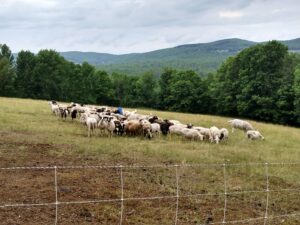
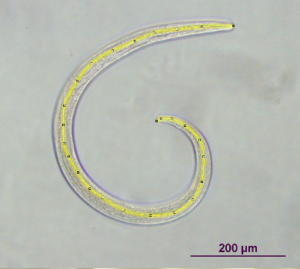
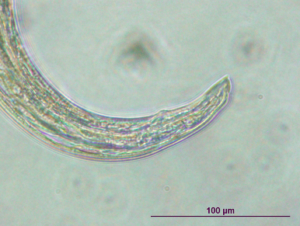
Treatment Results:
Pastured Poultry: On one farm, we conducted an opportunistic study based on farmer-design activity with their poultry. Approximately 200 laying hens were rotated about every four days within a 25,000 sq.foot pasture. Broiler chickens were observed for two weeks, but as they were rotated less frequently (once per 2 weeks), confined to 100 sq. foot chicken tractors and were less active, the data was omitted from the study. Chickens were supplemented with free-choice grain at all times. Vegetation was primarily grass and clover. The mean difference of before and after poultry exposure was statistically significant with a p-value of less than 0.01. This indicates that pastured poultry (laying hens) are an effective strategy for gastropod control.
(Note: No IACUC was needed, per committee instruction, for the pastured poultry study as the birds were cared for by one of the farmer participants and because there was no direct contact or manipulation from the researchers).
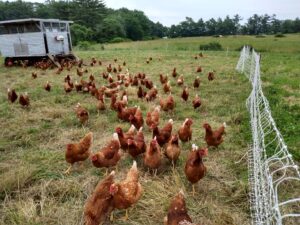
Mowing: Mowing took place at the University of Maine’s J. Franklin Witter Teaching & Research Center, also known as Witter Farm. This area carries a healthy population of Succineidae snails. A random complete block design was used with four blocks and three treatments (control, one year mow, two years mow). Each block consisted of three 30m x 20m randomized treatment sections for a total of twelve experimental units. Within treatment plots, 45 x 90 cm sections every 8 meters were surveyed for a maximum of 10 minutes. Gastropod abundance and diversity was documented as well as environmental conditions. Measurements occurred May- August, though equipment failures in the first year resulted in only 3 surveys. For the first year, t-test determined that mowed pastures have fewer gastropods than the control (not mowed) in the first 2 monthly observations (p=0.015 and < 0.01, respectively). With the combined two-year data, short-mowed areas had significantly fewer gastropods than the unmowed areas. There was a significant difference of repopulation onto the 1 year mow sites.
We received 65 responses to our nation-wide survey. Our conclusions are that producers are aware of brainworm as a risk to their livestock (95%), with 41% of farmers saying they experienced brainworm related illness on their farm. Survey data is currently being further analyzed. Several respondents from Maine contacted us to volunteer their farms for research. Communication with farmers is a current effort. Some notable results from the survey include:
Hobby farming/ pet livestock consist of 29%, partial income 55%, total income 9%, and other 7%.
Farmer respondents have diverse livestock, including cattle (8%), sheep (19%), pigs (7%), goats (13%), horses (8%), alpacas or llamas (30%), and other (15%). In the literature, brainworm has been documented in several of these mammalian species, expanding the overall importance of the present study.
Different grazing systems may be used on the same farm, especially those with alpacas/llamas and sheep.
Use of continuous grazing (one pasture all the time) is most common for alpacas/llamas; goats are the next most common livestock species to be continuously grazed.
Use of rotational grazing and dry lots is most common in alpacas/ llamas; sheep are the next most common livestock species to be rotationally grazed.
95% of survey participants had heard of brainworm prior to the survey.
41% of producers said they had suspected or confirmed cases of brainworm on their farm.
98% said their farm was near white-tailed deer habitat, and 88% said that deer were observed near their livestock grazing system.
82% of farmers said their poultry share pasture or housing with livestock.
This study of P. tenuis risk on Maine farms showed a wide variance of prevalence across all sample sites, largely due to management and environmental conditions. 5391 digested gastropod samples were analyzed in two years, of which approximately 2.5% were found to harbor meningeal worm (via morphological measurements). An average of 4.5% carried general larva, which included other worms, such as Muellerius capillaris, or sheep/goat lungworm, and environmental nematodes. Out of the six farms, three were completely low risk; one was generally low risk, but high risk in one specific area of a pasture. Two farms were high risk. Management which left dry soils and short vegetation due to overgrazing and compaction had little-to-no observed gastropods. Though deer feces contained P. tenuis stage-one larvae at these sites, without the intermediate hosts, the infection risk to livestock is considered to be low. The farms with low risk may have had some gastropod presence in early spring, but summer drought conditions quickly decimated populations. Farmers who used intensive rotating practices had higher soil quality, thus more gastropod presence, even through drought periods. Soil moisture and mixed vegetation were observed factors that correlated with abundance of snails. Areas with 100% grasses did not contain many gastropods, rather, fields with mixed dandelion or unmanaged burdock growth sustained snail populations even in drought conditions. We believe that these taprooted plants maintain moisture in the soil longer than clover and grasses, allowing for a perfect microhabitat for gastropods. Additionally, these plants have broad leaves which capture more dew and precipitation, allowing the snails to move for breeding purposes and foraging, thus increasing the chance of persistence.
The overwhelming majority (96%) of gastropods collected were amber snails, from the family Succineidae. This family is difficult to describe as to genus and species, even from genetic analysis (Perez et al., 2021). These snails are known vegetation climbers, a behavior that might increase risk of accidental consumption by both grazers and browsers. The snail lives a little over a year and can overwinter in the presence of frost; L1 larvae within them can also overwinter. Thus, persistence of these snails on pasture could contribute to longterm risk of P. tenuis livestock exposure.
The number of larvae within a snail also determines risk of disease. Different livestock species have different sensitivities to P.tenuis infection; alpacas and llamas are the most sensitive, with as little as 2-5 larvae causing symptoms, but sheep and goats can withstand slightly higher numbers, around 4-7. We found infected snails with dozens of brainworm larvae, with the highest containing 33. A dose this high could cause rapid symptoms and death in small ruminants, and in fact did so on one of our high-risk farms that had grazed their animals in the specific area days prior to surveying.
Gastropod management strategies were investigated through pastured Rhode Island Red laying hens and continuous mowing. Both methods significantly reduced Succineidae populations. In the second year of the mow treatment, plots which were allowed to regrow after being repeatedly mowed the year prior showed rebounded populations, though no juvenile gastropods were observed, suggesting that neighboring snails in control plots immigrated to the regrowth area. In contrast, the control plots had substantial snail juvenile numbers in the second year. This observation suggests areas with frequent mowing likely will not sustain breeding individuals. A recommendation for farmers experiencing high snail numbers on their pastures is to introduce actively foraging poultry breeds on pasture ahead of small ruminants in a rotational strategy. Another recommendation is to mow problem areas to a short grass height for at least two years in succession. A combination of these two treatments may also prove effective.
A potential setback to the pastured poultry control method is that birds may pass ingested larva through their digestive tracts. During an undergraduate capstone project in our lab, we inoculated Succineidae snails with stage one larva to incubate under controlled conditions, then fed snails with infective stage larvae to ten Grimaud hybrid meat-type ducks. Fecals from ducks were observed before and after infective gastropod exposure. Around 25% of stage three larvae passed though the ducks’ digestive system intact. However, there is little evidence suggesting that stage three larvae can survive outside of a host. In addition to poultry, mowing as a control method for gastropods is another method that farmers can try.
This project allowed us to conduct real time risk assessment for farmers and we were able to present timely management solutions. For example, we were able to identify a “hot spot” area of a field where small ruminants were grazed the week prior. After examining several snails from that area with up to 33 P. tenuis larvae, we connected with the farmer to keep an eye out for symptoms and advised them to contact their veterinarian for preventive actions. They ended up losing one sheep abruptly after our conversation (we were unable to obtain it for necropsy, however).As a result of sharing this information, the other animals were treated with a precautionary anthelmintic. Three farms that had a high level of risk benefitted from our research in real time and utilized our management recommendations. All farmers on the six farms expressed a knowledge change.
By giving presentations at venues such as Food Animal Concerns Trust (FACT), the Maine Agricultural Trade Show, the Maine Fiber Frolic, the Conference for Research Workers in Animal Diseases, and more, we were able to stimulate discussions among farmers and agricultural professionals about meningeal worm risk, symptoms, and management.
Perez, K. E., Martinez Cruz, M. A., Steury, B. W., & Barker, G. M. (2021). A fresh start in ambersnail (gastropoda: Succineidae) taxonomy: Finding a foothold using a widespread species of oxyloma. European Journal of Taxonomy, 757 (1) https://doi.org/10.5852/ejt.2021.757.1419
Education & Outreach Activities and Participation Summary
Participation Summary:
In the past year, several presentations and educational abstracts were produced related to this project.
|
Date |
Venue |
Product |
|
April 2023 |
Food Animal Concerns Trust (FACT) |
Presentation: "Meningeal Worm Transmission Factors: Problem and Prevention on Small Ruminant Farms." 193 live viewers/ 195 video views. |
|
Nov. 2022 |
American Association of Veterinary Laboratory Diagnosticians Conference. |
Abstract and Presentation “Necrosuppurative meningomyelitis and perineuritis in a lamb with presumptive in utero Parelaphostrongylus tenuis infection.”
|
|
June 2022 |
Maine Fiber Frolic |
Presentation, “Assessing Gastropods as Parasite Vectors: Reducing Risks on Maine Farms," |
|
Jan. 2022 |
Maine Agricultural Trade Show (virtual) |
Presentation, “Assessing Gastropods as Parasite Vectors: Reducing Risks on Maine Farms,” and “Assessing Microplastic Risks in Maine’s Agricultural Systems.” https://www.maine.gov/dacf/php/nutrient_management/education.shtml |
|
Dec. 2021 |
Conference for Research Workers in Animal Diseases, Chicago, IL |
Poster presentation, “Assessing Gastropods as Parasite Vectors: Reducing Risks on Maine Farms.” |
|
April 2021 |
UMaine Student Symposium (virtual) |
Presentations, “Risk management solutions for brainworm (Parelaphostrongylus tenuis) on farms with domestic livestock,” and, “Control of a Ruminant Pathogen, Parelaphostrongylus tenuis, Using Poultry: Effects of Gastropod Diets on Ducks,” |
|
April 2020 |
Extension Risk Management Education National Conference, Denver, CO (moved online) |
Poster presentation, “Grazing with White-tailed Deer: Simple Solutions for Complex Problems.” https://agrisk.umn.edu/Conferences/Record/2020_extension_risk_management_education_nati |
|
Jan. 2020 |
Everyday Farmers Conference (virtual) |
Presentation, “Small Ruminant Health.” |
|
Dec 2019 |
UMaine Extension Cows and Crops E-Newsletter |
Article, Managing Pastures to Reduce Risk of Meningeal Worm ("Brainworm" or Parelaphostrongylus tenuis) Infection in Ruminants |
Outreach products developed as a result of the project include the following:
- Conference for Research Workers in Animal Diseases Conference Poster
- Maine Fiber Frolic Slideset
- Maine Agricultural Trade Show, 2022 Recorded presentation
- American Association of Veterinary Diagnosticians Conference Slideset
Project Outcomes
This project investigating risk factors and mitigation methods for meningeal worm has helped farmers on a local and regional scale make important decisions around their small ruminant management. Each of our six farmers participating in our research has expressed how this project has been beneficial to them. All stated they gained knowledge of best management practices to avoid risk, and of the worm’s lifecycle and the role of gastropods as intermediate hosts. Farmers with high risk, and those that may experience an increase in risk under the right conditions, all stated they would implement the practices (mowing and/or pastured poultry) that we investigated, either as a treatment or prevention. We were also able to communicate with these farmers in real-time to give warning of areas to avoid grazing their animals. A Food Animal Concerns Trust poll after our presentation indicated 44 of 46 respondents learned new material, with 35 respondents reporting they intend to adopt one of our management practices. There were 299 people across North America who were registered for this event.
An unexpected collaboration included a veterinarian who reached out to us for consultation on meningeal worm risk factors in pastures. We talked at length about different areas of concern in one of the research farms as well as our general findings. Several veterinarians have agreed to be surveyed about their knowledge and risk perception regarding P. tenuis infection in small ruminants. Clinical veterinarians interact directly with the public and are highly valued educators about animal health. We hope the communication we’ve had with these professionals will trickle down to improve producer education.
All farmers participating in our project mentioned a need for networking and collaboration among small ruminant producers in the state. All the farmers involved in our project mentioned that one resource they utilize for advice is another farmer. Farmer-to-farmer networking and veterinarian-to-farmer communication is extremely important for information, like ours, to become sustainable. By having conversations with these stakeholders at conferences, fairs and trade shows, we hope to influence decision making that will enhance animal health in Maine and the Northeast.
This project has enlightened us to the current need, as well as future research possibilities, of prevention efforts for not just meningeal worm risk reduction, but also for other pests like ticks. During presentations, several people, including agricultural educators, were unaware of the efficiency of poultry on pastures. This provided educational opportunities to highlight this treatment method for gastropods- borne vector control, as well as soil nutrient management.
This venture has also revealed a need for animal health management and farmer behavior assessment and education across the region. One area of future focus is an effort to bring an experienced group of small ruminant farmers together to form a panel with the purpose of generating information. We hope to create a network of information gathering. Topics could include parasite and disease prevention and treatment, predation conflicts, farm biosecurity, grazing and pasture management, etc.
An incidental finding of this research was the presence of microplastics within gastropods and livestock and deer feces. This finding generated a further study into the prevalence of larvae and microplastics within gastropods, hypothesizing that the presence of plastics would make the gastropods more susceptible to larval infection. Another effort was the formation and dissemination of a survey for farmers on their attitudes and practices dealing with plastics. This is an important topic with human, animal and ecological significance.
